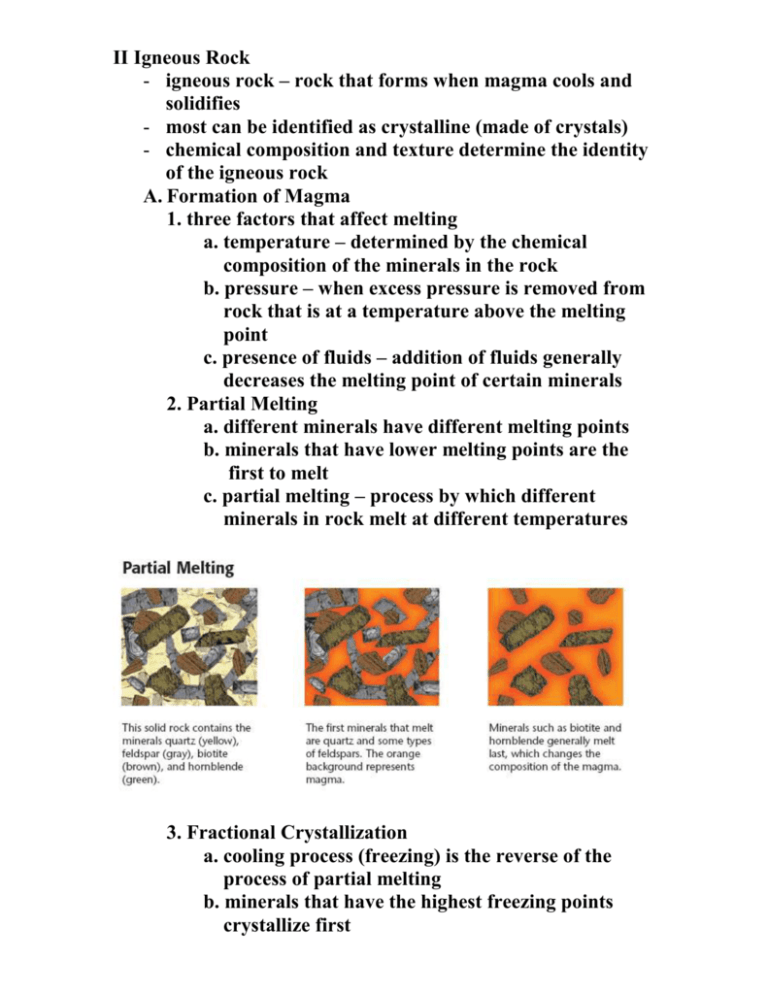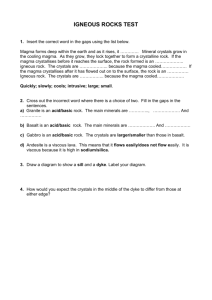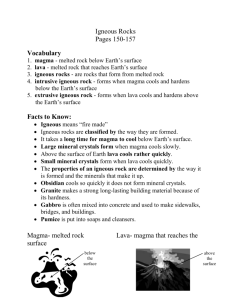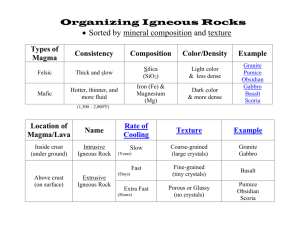II Igneous Rock - Moore Public Schools
advertisement

II Igneous Rock - igneous rock – rock that forms when magma cools and solidifies - most can be identified as crystalline (made of crystals) - chemical composition and texture determine the identity of the igneous rock A. Formation of Magma 1. three factors that affect melting a. temperature – determined by the chemical composition of the minerals in the rock b. pressure – when excess pressure is removed from rock that is at a temperature above the melting point c. presence of fluids – addition of fluids generally decreases the melting point of certain minerals 2. Partial Melting a. different minerals have different melting points b. minerals that have lower melting points are the first to melt c. partial melting – process by which different minerals in rock melt at different temperatures 3. Fractional Crystallization a. cooling process (freezing) is the reverse of the process of partial melting b. minerals that have the highest freezing points crystallize first c. fractional crystallization – the crystallization and removal of different minerals from the cooling magma 1c. minerals that form first tend to settle at the bottom of the magma chamber or stick to the ceiling and walls of the magma chamber 2c. crystals that form early are commonly the Largest - Why? - they have the longest to grow B. Textures of Igneous Rock - classified according to where magma cools and hardens - intrusive igneous rock – rock formed from the cooling and solidification of magma beneath Earth’s surface - extrusive igneous rock – rock the forms from the cooling and solidification of lava at Earth’s surface - texture of igneous rock is determined by the size of the crystals in the rock 1. Coarse-Grained Texture a. intrusive igneous rocks commonly have large mineral crystals b. slow loss of heat allows the minerals to form large, well-developed grains c. coarse-grained texture – igneous rock that are composed of large mineral grains (ex. granite) 2. Fine-Grained Texture a. many extrusive igneous rocks are composed of small mineral grains that cannot be seen by the unaided eye b. magma (lava) cools rapidly c. large crystals are unable to form d. fine-grained texture – igneous rocks that are composed of small crystals (ex. basalt and rhyolite 3. Other Igneous Rock Textures a. porphyritic texture – igneous rock that has a mixture of large and small crystals b. glass texture – highly viscous magma cools quickly that contains a very small percentage of dissolved gases (obsidian) c. vesicular texture 1c. igneous rock that contains vesicles 2c. vesicles – holes that are formed in igneous rock from highly viscous magma that has a high percentage of dissolved gases that become trapped as bubbles in rock C. Composition of Igneous Rock - the mineral composition is determined by the chemical composition of the lava/magma 1. Felsic Rock a. felsic – describes magma or igneous rock that is rich in feldspars and silica and is generally light in color b. commonly also contains plagioclase feldspar, biotite mica and muscovite mica c. examples include granite, rhyolite, obsidian and pumice 2. Mafic Rock a. mafic – magma or igneous rock that is rich in magnesium and iron and that is generally darker in color b. main mineral components are plagioclase feldspar and pyroxene minerals c. ferromagnesian minerals – minerals that are rich in iron (Fe) and magnesium (Mg) d. examples include basalt and gabbro 3. Intermediate Rocks a. made up of minerals plagioclase feldspar, hornblende, pyroxene and biotite mica b. contain lower portions of silica than felsic c. contain higher portions of silica than mafic d. examples include diorite and andesite D. Intrusive Igneous Rock Structures - intrusions – rock masses that form underground - forms when magma intrudes or enters into other rock masses and then cools deep inside Earth’s crust 1. Batholiths and Stocks a. batholith 1a. largest of all intrusions 2a. spread over 100 km2 3a. means “deep rock” 4a. form the cores of many mountain ranges, such as the Sierra Nevadas b. stock – similar to batholiths but cover areas less than 100 km2 2. Laccoliths a. pushes overlying rocks into a dome b. means “lake of rock” c. commonly occur in groups d. ex. Black Hills of South Dakota 3. Sills and Dikes a. sill 1a. magma flows between layers of rock and hardens 2a. lie parallel to the layers of rock that surrounds it 3a. vary in thickness from a few centimeters to hundreds of meters b. dike 1b. forms when magma follows existing vertical fractures or creates new ones and solidifies 2b. cut across rock layers rather than lying parallel 3b. common in areas of volcanic activity E. Extrusive Igneous Rock Structures 1. rock masses that form on Earth’s surface 2. volcano – a vent or fissure in Earth’s surface through which magma and gases are expelled 3. volcanic neck – solidified central vent of a volcano 4. lava flow – flat masses of rock 5. lava plateau – series of lava flows that cover a vast area with thick rock 6. tuff – volcanic ash deposits that can be hundred of meters thick and cover areas of several hundred km








